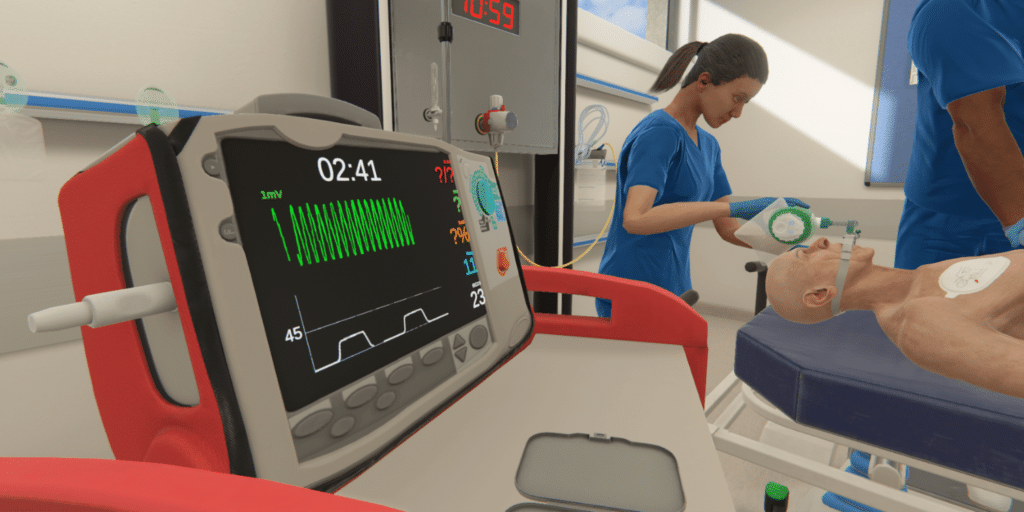Healthcare is a fast-paced, patient-centered industry. To keep pace with advancements and increasing amounts of knowledge requires continuous learning, developing new skills, and maintaining foundational skills.
The advancement of technology has made waves in the healthcare sector, and as tech continues to improve rapidly, its uses and functions evolve, as well.
The issues facing nursing today
In the United States, for nursing, in particular, there is serious concern about the rising rates of turnover. This costs employers around $52,000 on average for each turnover, and it may also place an additional workload on remaining employees while the employer recruits and hires a new RN, which can often take about two to four months.
Many nurses are making their voices heard and their concerns known. Hear Us Out, a campaign launched by the American Association of Critical-Care Nurses, reports that 66% of acute care nurses surveyed stated that they considered leaving the profession following their experiences during COVID-19.
These circumstances are likely exacerbated by the projected nursing shortage, which is expected to impact at least 30 states by 2030. This impact is already becoming observable – in 2021, the total number of RNs experienced its most significant decline in over 40 years, with over 100,000 nurses lost, many under 35.
Younger nurses are demonstrating greater feelings of anxiousness and lesser feelings of emotional well-being compared to their counterparts over 55, according to the Two-Year Impact Assessment conducted by the American Nurses Foundation.
Impacted by workforce shortages and declining well-being, about 52% of all nurses surveyed reported that they have considered leaving or intend to leave the profession entirely. Of those who may leave, 63% were under 35.
With approximately 800,000 nurses planning to leave by 2027, it’s clear that left unaddressed, this could quickly become a crisis.
Alarmingly, a large majority of new nurses are viewed as underprepared for practice as reported by their employers.
In fact, about 91% of new nurses assessed in terms of their readiness to practice fell outside of the acceptable range for competency.
These rising expectations are so well-known that the NCSBN generated an entirely new generation of the NCLEX in order to accommodate and reliably assess the concept of clinical judgment for entry-level nurses.
And while the well-being of hospital employees is imperative for a healthy work environment, patients are also likely to suffer in the wake of this looming healthcare crisis.
Nurses entering the profession need to be adequately prepared to practice, and they need to be supported by their employers.
Advancing technology, like virtual reality simulation, is one component of a much larger plan needed to address the issues above and positively change the state of the nursing industry.
Virtual reality in healthcare: An overview
Virtual reality simulation is used by many disciplines across the healthcare spectrum, and there are three main areas where VR is often seen – therapeutic, clinical, and education & training.
For therapeutic purposes, practitioners are often using virtual reality simulations with patients at the helm of the scenario. This is seen in physical therapy treatment during stroke rehabilitation, and in other areas of healthcare such as the management of chronic low back pain.
Clinically, VR is often seen being used to facilitate skill development and procedural processes, such as laparoscopic skills.
Educational institutions are embracing this new wave, as well, and are embedding virtual reality into curricula, developing a foundation of virtual reality simulation for their students, and they are often finding positive feedback and engagement from their students.
For example, medical students have been using VR as a means to develop empathy for their soon-to-be patients.
From the beginnings of developing a new skill through the transition to practice and into continuing education and training, virtual reality is being used to bolster learning and prepare students and clinicians for practice.
Beyond education and into practice, VR has been used in areas including:
- Assessment
- Transition to practice
- Onboarding
- Training
Assessment
Often, assessment involves completing a written multiple-choice exam or standing up in front of a room to give a presentation.
You’re probably pretty familiar with exams like the Next Generation NCLEX which utilizes a written format to test concepts like clinical judgment and make determinations about a test-taker’s readiness to practice.
In other ways, having an assessor observe and grade a learner in a physical simulation is a means for testing, as well.
Perhaps you’ve utilized or interacted with live patient actors as a way to grade technical or communication skills, but have you ever thought about using virtual reality to achieve the same goal?
At Oxford Medical Simulation, a team of in-house Clinical Authors use their professional experiences to inform, ideate, and create holistic, true-to-practice scenarios based on current evidence and best practices.
Because these scenarios are standardized, you can utilize them to determine a benchmark that signals a learner has met the criteria for demonstrating a given skill or set of skills.
University College Birmingham, for example, has increased their use of VR simulation for both educational and, now, assessment purposes.
The faculty at the university collaborated with one another to determine which scenario was most appropriate for their learners, and they collectively decided on a particular score that would serve as a marker showing learners had passed the assessment.
As OMS scenarios provide automated feedback and rationale, learners have quick access to resources that give them greater context into how they led the situation, what could have gone better, and why certain skills or timestamps are particularly important.
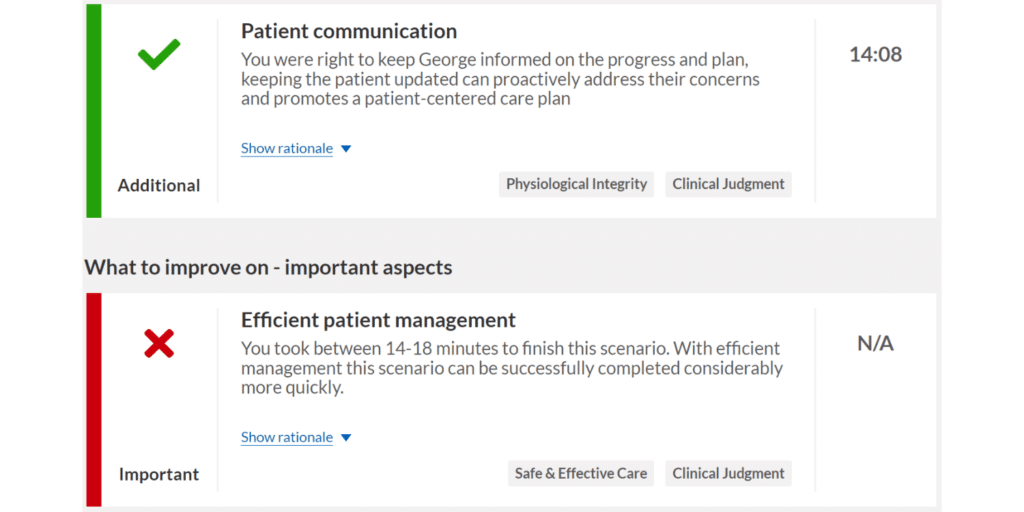
Using VR for assessment isn’t limited to healthcare students – licensed healthcare professionals can also participate in testing this way.
Virtual reality clinical simulations have already been used to assess procedural or technical skills, like surgical endoscopy skills. From medical students to experienced clinicians, this study demonstrated a means by which skills could be measured across a range of experience levels, meaning students and practitioners, alike, can use VR as a tool to assess their skills.
Even more difficult-to-test concepts like clinical judgment or competence have been tested using virtual simulations, giving more weight to the notion that virtual reality simulations can offer a way to conduct formative assessments in practice.
Assessing readiness is one way to help learners prepare for the transition to practice, whether they’re taking on an entry-level role or if they’re returning to the clinic in a new or advanced position. The transition to practice is an essential time to provide support and resources to learners.
Transition to practice
Virtual reality clinical simulations offer a unique opportunity for learners to take on a lead role in the clinical setting, providing a safe space for learners to immerse themselves in their respective positions, and for learners who are newer to their roles, it’s a chance to explore and more deeply understand the requirements and daily responsibilities of their new position.
Learners get a first-person perspective on providing patient care while managing their other responsibilities, particularly within the context of low-frequency, high-stress situations that aren’t often seen in the clinical setting or that are difficult to simulate traditionally.
Taking on the lead role of the nurse or physician, for example, places learners in a position to direct the outcome of the simulation. A given scenario can result in a range of different outcomes, meaning the learner’s decisions and actions directly influence the results of the scenario.
Learners are able to see the consequences of errors play out in real time, without ever placing patient safety at risk.
As competency builds and complexity increases, more intensive VR scenarios can be used that reflect building and managing a caseload of multiple patients.
This set of scaffolding scenarios builds upon itself, with a beginning caseload of a single patient and ending with a caseload of five patients.
In these types of situations, learners will have to utilize the skills they’ve already learned to manage a caseload with increasing complexity; learners will need to delegate tasks, prioritize and adapt to new information, and they will need to do all of this while managing their time, as well.
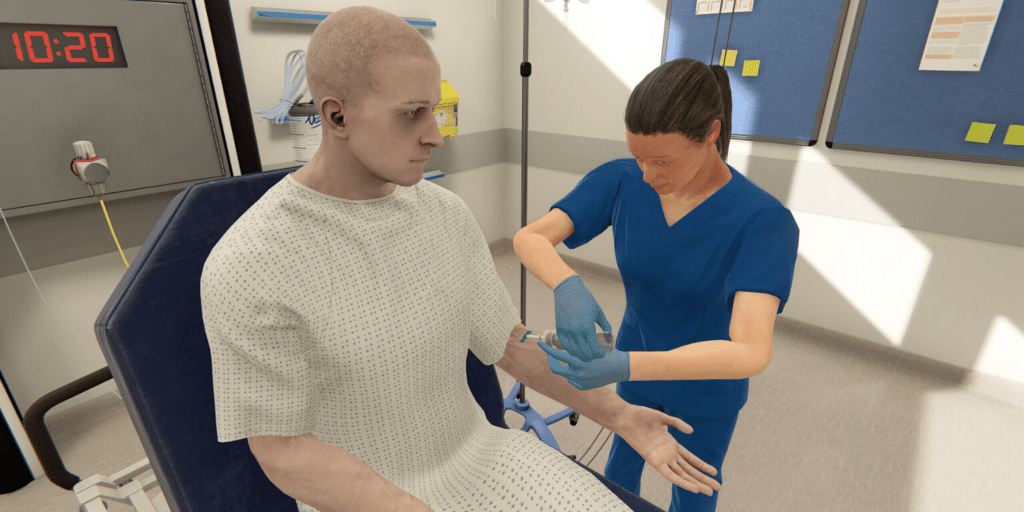
VR clinical simulations can be used to grow with learners, supporting them as they build their knowledge base and skill set, from entry level to graduate or doctorate level – VR is already being used to help learners beyond the classroom and in the clinical setting.
Onboarding
Virtual reality can be used to support new trainees as they onboard and get familiar with their new work environment.
Stamford Health, a hospital system in Connecticut, is utilizing VR to help entry level nurses in their transition to practice.
As a part of their GEMS program, Stamford uses virtual reality simulations to prepare and assess new nurses’ readiness for practice as they go through a comprehensive onboarding program designed to guide them as they become practicing nurses.
Some facilities may choose to customize VR simulations for an even more realistic reflection of the actual hospital setting, so that newly hired personnel can become quickly familiarized with their new work environment.
VR can be used to identify and remediate knowledge gaps amongst new and more experienced staff.
To begin the process of bringing teams together, VR simulations can be used to help with team building, demonstrating dynamics which may be different from facility to facility, and giving newly hired personnel a chance to practice working with their colleagues.
This also gives experienced employees a chance to get to know other members of the healthcare team, and it can be used to encourage cross-disciplinary collaboration with interprofessional scenarios.
Training
From the big to the small events, virtual reality simulations can be made to reflect almost any environment.
Facilities may choose to use virtual reality as a means to identify and remediate knowledge gaps amongst staff, run interprofessional scenarios involving multiple disciplines, or they may use scenarios to further continuing education for their providers.
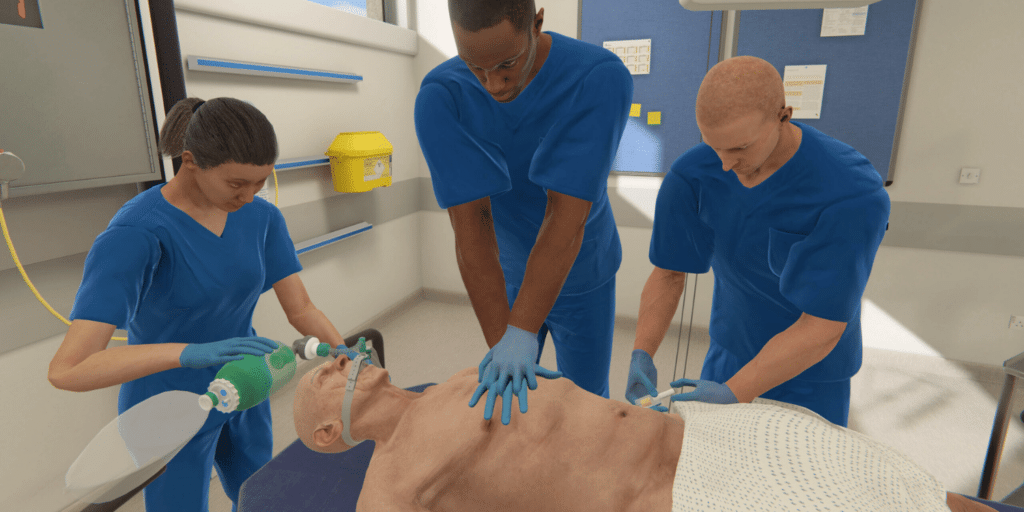
Cases can be tailored to fit the typical cases seen in a given environment. For instance, a women’s health clinic may use a scenario involving preeclampsia whereas an emergency department may use an ACLS simulation.
Virtual reality is already being used to support training for particular cases like those involving diabetic emergencies.
VR simulations have also been used to keep staff fresh on specific, low-frequency, high-stress situations, such as in the case of cardiopulmonary resuscitation following a cardiac surgery.
While many virtual reality simulations focus on procedural and technical skills, there are many non-technical skills that can be practiced in-scenario.
For instance, the use of voice control allows a learner to speak directly with a virtual patient, providing a safe place to practice communication skills, motivational interviewing, or engaging in crucial conversations.
From students to newly-licensed practitioners to advanced providers, virtual reality simulations can be a valuable tool for any level of learner, whether your goal is to keep a general skill well-practiced or to recognize signs of an emergent, uncommon condition, virtual reality provides numerous benefits across the spectrum of healthcare.
Benefits
For many of those in training or continuing their education, practice is an essential part of the process.
VR simulations offer unlimited repeatability of scenarios, granting learners the chance to work on skills until they feel comfortable or until they demonstrate competence as determined by the faculty or facility trainers.
The flexibility of a headset or a computer-based simulation means less emphasis on scheduling and coordination of schedules and more focus on skill-building and refresher training.
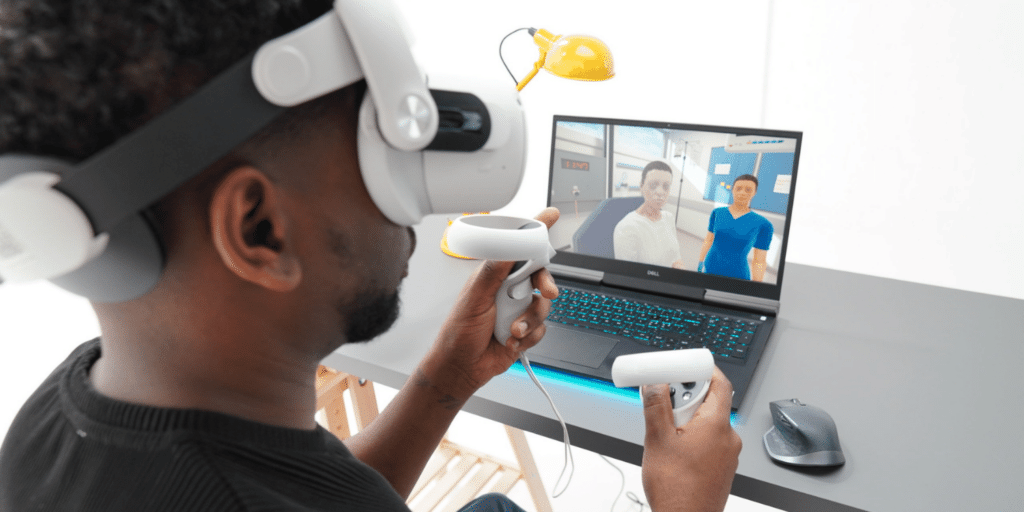
Training can be conducted anywhere, from a large, high-tech simulation lab to a small room with one outlet – you can take VR anywhere. VR can bring about more convenience, less setup and breakdown time, and fewer administrative tasks to juggle.
Setting up VR simulations can often result in cost savings, whether that be in setup and implementation or in maintenance costs. Quick, reliable, easy-to-use VR headsets can mean more time saved by faculty and staff, and fewer resources needed for simulation training.
Creating a safe space for learners to practice is also essential, and VR use offers learners the ability to make mistakes in a psychologically safe environment, opening up dialogue and allowing for reflective thinking to improve future performance.
The ability to stay up-to-date on relevant materials and skills, practice low-frequency situations, and work with colleagues in scenarios may have a positive impact on the state of the nursing industry, as well.
What's next for VR in healthcare?
As VR is already in use for a wide range of outcome measures, like clinical decision making, procedural skills, communication skills, and teamwork, with the continuing rapid development of this technology, the possibilities are endless.
Haptics and hand control allow for tactile feedback, adding another layer of immersion to the realism of VR, along with voice control, which allows for learners to speak throughout the scenario.
With authoring platforms, the possibilities widen even further, allowing for facilities to create their own bespoke content, complete with their own case summaries and learning objectives. Scenarios can be made less or more complex, depending on the learner level and desired outcomes.
There are so many ways in which virtual reality is already being used in healthcare education and training, and as VR continues to be embedded into curricula and training programs, there will continue to be more avenues for its use as a tool from education and into practice.
For more information or to speak with someone about how virtual simulation can fit your specific needs, schedule a time to discuss with us here.
